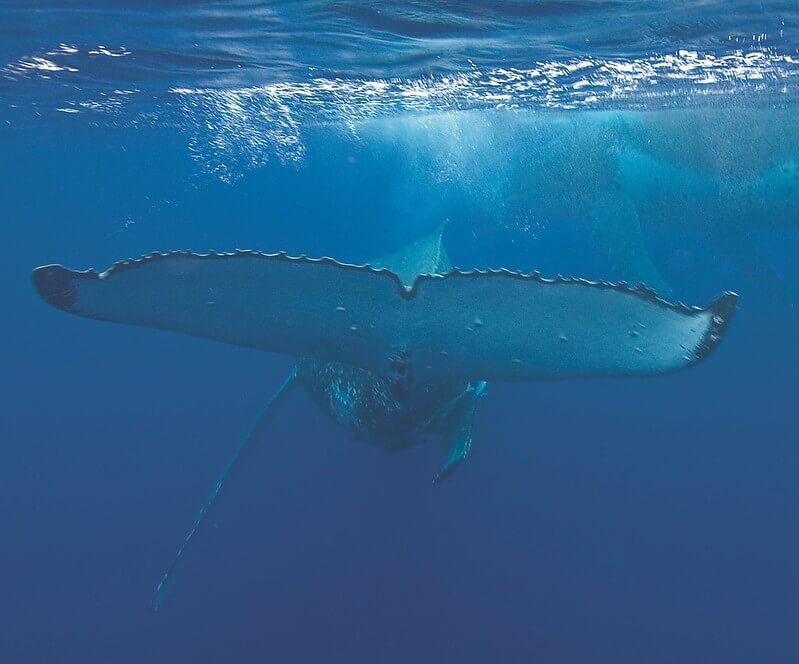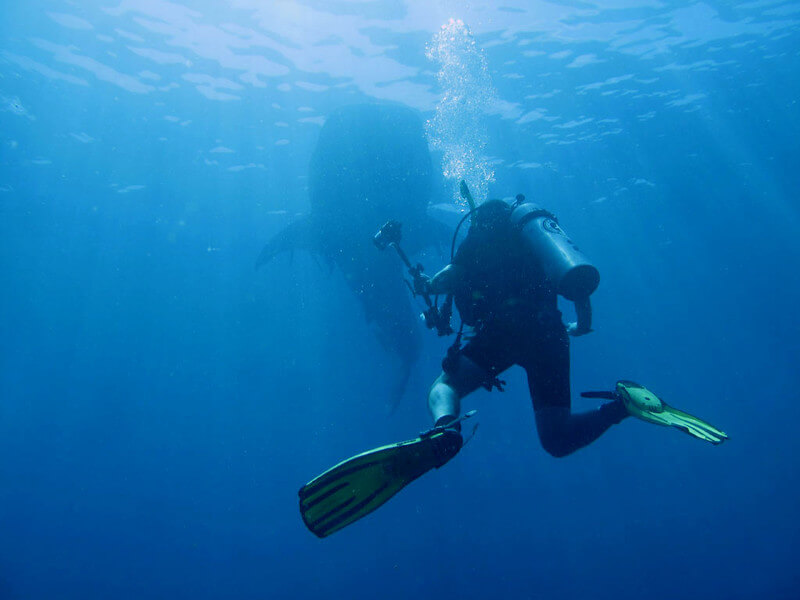I am positive that all ocean lovers, such as myself, have at one point or another dreamed about swimming alongside the ocean’s gentle giants.
When you think about the sheer size of even the smallest whale it’s easy to dismiss this dream because it must simply be too dangerous to do so.
Well, today I am here to tell you to bring back that childhood dream because it is absolutely possible my friend!
It’s true that swimming with such colossal creatures can have some risks but if done responsibly you have nothing to worry about.
Read on as I break down a complete “how to swim with whales” guide so that you can start planning the adventure of your dreams!
Do People Really Swim With Whales?
Not only do people really swim with whales, but it has been happening for several decades.
The first commercial “swim with whales” program was developed in the mid-1900s in Australia.
The idea started cooking after a group of dwarf minke whales started curiously approaching snorkelers.
The whale-watching and swimming industries have grown a great deal since their early stages currently generating over 2 billion US dollars annually and making it possible for people around the world to fulfill this lifelong dream.
Is It Safe To Swim With Whales?
The fact that any whale species weighs at least several tons makes them inherently dangerous as even an accidental bump of the caudal or pectoral fin could cause serious physical harm to a person.
However, these creatures are so gentle that as long as you are respectful of their space and follow instructions properly you will be very safe.
There have only been 2 reported incidents, resulting in 3 people getting hurt by humpback whales.
These incidents were 100% due to mistakes made by the swimmers and not deliberate instances of aggression from the whales.
Nevertheless, when you take into account that humpbacks weigh 30 tons it’s not hard to see why irresponsible actions can lead to injury.
It is also important to note that all three people involved in these encounters experienced a speedy and full recovery.
To make sure you don’t have a negative experience I will break down how to do so safely.
How To Swim With Whales Safely
Most species of whales have a worldwide distribution so even though you can really swim with them anywhere I highly recommend you choose a reputable tour operator that will guarantee your safety as well as the whales.
A responsible tour operator will be one that is respectful to whales, follows the rules set in place to protect these magnificent creatures, and is fully permitted by authorities to provide such services.
It is of vital importance that you do your part and read up on the local laws regarding whale swimming experiences in the particular country you have chosen for your once-in-a-lifetime adventure.
You can find the resources to help you choose a country and a tour operator responsibly by studying the “whale watching handbook” put together by the IWC (International Whaling Commission).
Swimming with whales in the wild is a different ball game. Whilst the animals are much the same, you’ll need to take extra caution and ensure that you’re well prepared for the situation.
Can You Swim With Any Whale Species?
There are several species of whales you can swim with, the most popular by far is the humpback whale.

What makes this cetacean so popular besides its wide distribution and world-famous acrobatic displays is the fact that it is very curious around boats rarely shying away from eager watchers.
Countries that offer swimming with humpback whales include:
Dominica Island, Dominican Republic, Australia, Norway, La Réunion Island – France, Mozambique, Tahiti, Sri Lanka, Tonga, Mexico, California – USA, Colombia, among others.
Other species that people can swim with include:
- Sperm whales: Azores Island, Portugal; Dominica Island.
- Pilot whales: Dominica Island.
- False killer whales: Dominica Island.
- Dwarf minke whales: Great Barrier Reef, Australia.
- Southern right whales: Mozambique, Africa.
- Blue whales: Azores Island, Portugal; Sri Lanka.
- Fin whales: Norway.
What Not To Do Whilst Swimming With Whales
I can not stress enough how important it is that you choose a reputable and responsible tour operator for your whale-swimming experience.
This will ensure that all rules are followed to guarantee your safety and enjoyment as well as the comfort of the whales you and I love so much.
Your tour operator will provide very thorough instructions regarding what you can and can’t do while in the water with these majestic cetaceans.
Additionally, I have gathered a few important rules of etiquette you should follow during your encounter:
- NEVER get in the water with an active group! Males will be fighting each other for the chance to mate. It is very easy to get caught in the middle and end up badly hurt.
- Get in the water calmly and slowly. Don’t jump in, scream or splash. Once in the water make sure your fins are completely submerged before you start swimming. Cetaceans slap their fins on the surface as a sign of annoyance, you don’t want to send the wrong message.
- Don’t swim toward a whale from behind or from the front as it will feel preyed on. You should always swim alongside and in a parallel position.
- NEVER swim straight toward a whale, you will just make it swim away. Stop and stay in your spot, preferably at about 100 m / 328 feet until the whale approaches you.
- Never surround the whale. Whether it’s boats or divers it will make it feel uncomfortable and just leave. Needless to say, if a whale starts to flee don’t harass it.
- Never touch the whale! You could pass on harmful bacteria to the whale and vice versa, don’t forget they are wild animals after all.
Final Thoughts
The opportunity to swim with whales has been a powerful driving force impulsing marine mammal conservation.
Local communities have been able to view these large cetaceans as something they can profit from by keeping them alive and marketing them as tourist attractions.
It might sound cold to describe them as such but please bear in mind that these same communities greatly benefitted from killing and selling these animals by the pound at the local markets not too long ago.
As whale swimming experiences grow in popularity so do the risks as more tours equal more boats that could possibly harm the whales or stress them in a way that their normal mating and breeding patterns become affected.
Consequently, it is of vital importance that when you purchase this sublime experience you do it from a respectable operator, therefore, guaranteeing that you aren’t supporting malpractice that can endanger the whales you and I love so much.
I am a lover of everything nature and animal related with over 15 years of experience in the field of wildlife rescue and education. Currently living in Colombia working with wild and domestic animals and spending all my free time writing about them 🙂

